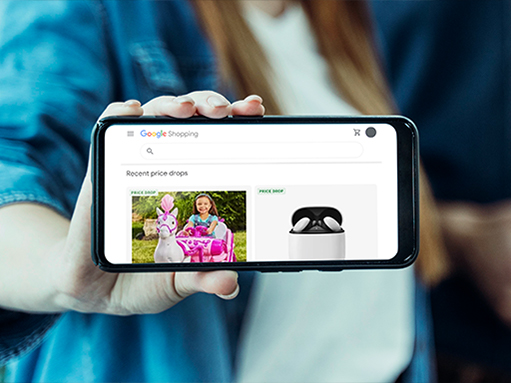You decided to start running Smart Shopping campaigns—but you’ve hit a wall. Where are the segmentation options? How can I budget? How do I attribute sales? These are all common problems with Smart Shopping campaigns.
As we continue to work with these campaigns, we’ve discovered ways to make Smart Shopping campaigns profitable, and we want to share our findings with you. In this blog, we’ll help you overcome common problems with Smart Shopping campaigns, so you can enjoy the benefits of these automated campaigns.

Problem #1: Limited Segmentation
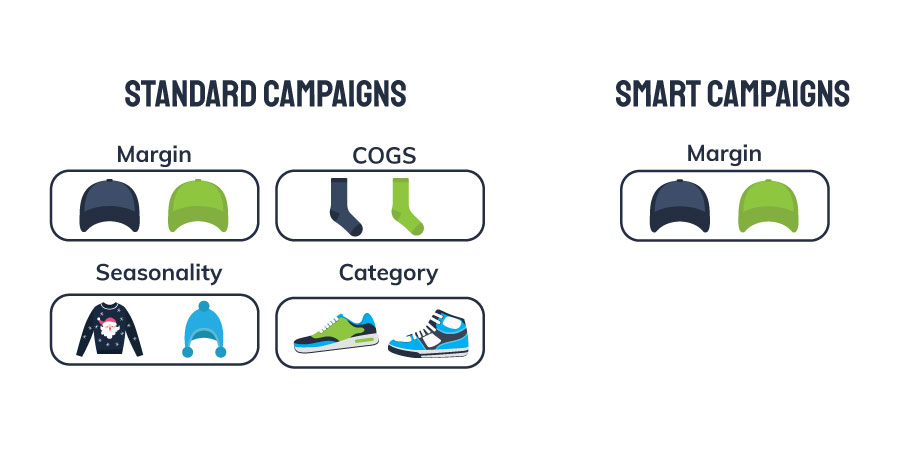
In a standard campaign, we use a variety of techniques to extract maximum profit including keyword segmentation, product segmentation, feed optimization, and more. Unfortunately, Smart Shopping campaigns don’t give you all of these options because they aren’t designed to be customizable—they’re designed to be hands-off.
For automation to work its magic in Smart Shopping campaigns, your ad groups need to contain a sizable segment of products (this gives the AI more data to work with).
In standard shopping campaigns, we recommend segmenting your products by available margin as well as across a variety of parameters including seasonality, category, top sellers vs. poor performers, and more. Using this strategy allows you to finely tune where your ad dollars go.
In Smart Shopping campaigns, we recommend segmenting by margin. Since it’s not possible to segment as narrowly, you should use the most important factor: margin. Learn how to segment by margin here.

Problem #2: No Guidelines for Bidding
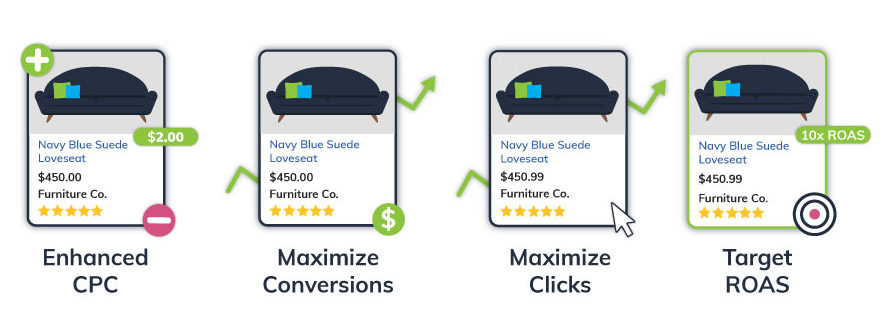
Bidding and ad placements are automated for Smart Shopping campaigns using four different bidding strategies: maximize clicks, enhanced CPC (eCPC), target return on ad spend (Target ROAS), and maximize conversion value. Using machine learning, Smart Shopping campaigns try to find the ideal bid to help you reach your goals by taking historical data into consideration.
If you want more control over your ad spend, we suggest choosing “Target ROAS” for your bidding strategy. This allows you to set ROAS targets that can help you maximize your profit. To do this, you’ll first need to calculate your Target ROAS. Read our guide to learn how to choose a profit-driven ROAS target!
This target won’t always be the same. You’ll need to calculate and update your ideal targets to account for changes in the cost of goods or variable overhead. Don’t forget about seasonality, either! Apply seasonality adjustments where necessary.

Problem #3: Unable to Set Budgets
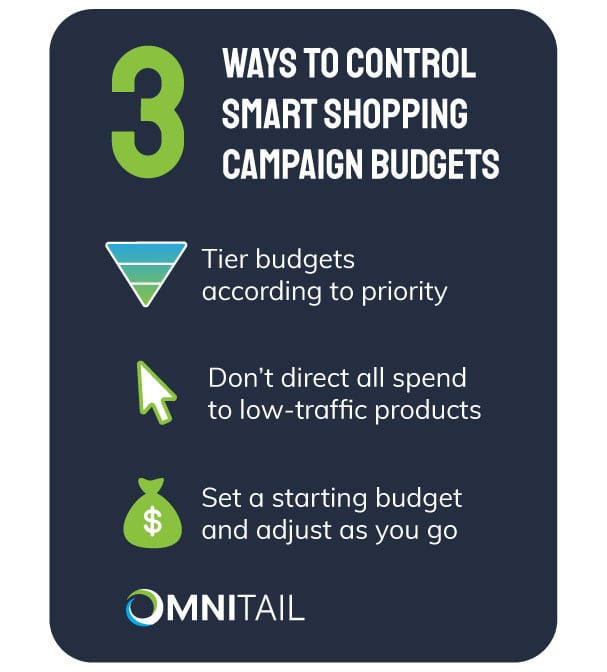
Smart Shopping campaigns tend to spend whatever budget they’re given. This is why controlling your budgets is very important for Smart Shopping campaigns—but how can you keep them in line? There are a few ways you can regulate your ad spend.
Tier Your Budgets
One way is to tier your budgets according to the priority of your campaigns. For example, if you have highly seasonal products that you want to push now, allocate more budget towards those products.
Direct Spend Wisely
Conversely, if you’ve moved low-traffic products into Smart Shopping campaigns to boost their success, don’t spend your entire budget on these low-traffic products. Stay aware of which products you want to prioritize and reflect that in your budget strategy.
Adjust as You Go
You can also take a more ad hoc approach to budgeting, and just start with an amount you’re comfortable with and add or subtract spend according to profit generated.
You simply won’t have the same level of control that you do with standard campaigns in an automated campaign. Capping budgets for Smart Shopping, though, gives you slightly more control than you would have otherwise—and helps keep your automated campaigns profitable.

Problem #4: Smart Campaigns Take Traffic From Standard Campaigns
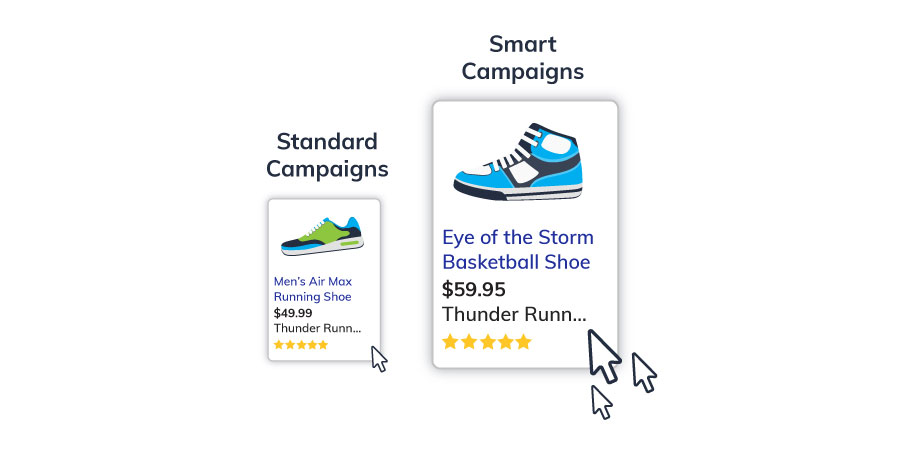
If you’ve tried running Smart Shopping campaigns and manual campaigns at the same time, you might have found that the vast majority of clicks flowed to your Smart Shopping campaigns.
If this happened to you, don’t give up on running both campaigns at the same time! While it’s true that Smart Shopping is prioritized when SKUs that appear in both manual and Smart Shopping campaigns, it’s not impossible to run both types of campaigns together.
In fact, we often run manual and Smart campaigns alongside each other for our clients. So how do we keep the campaigns in check?
1. Choose Products Carefully
First, you need to choose your products carefully for Smart Shopping campaigns. If you have in-house, specialized products that perform really well in your standard campaigns, you could push those products using Smart Shopping campaigns.
Alternatively, if you have low-traffic products in your Standard campaigns, you could put them in Smart Shopping campaigns to see if they get more traction. Learn more about using Smart Shopping campaigns to boost traffic in this white paper.
- 2. Plan Budgets
The second ingredient is carefully planned budgets. How much do you want your Smart Shopping campaigns to spend vs. your manual campaigns? Pay attention to your campaigns and know what you’re comfortable spending. Understanding the relationship between your ad spend and profitability will help you plan intelligent, profitable budgets.
- 3. Consider Profitability
Finally, always look at profitability. Like we just mentioned, you need to make your ad dollars drive profit for your business. No matter the campaign, make sure you’re driving spend towards your most profitable products. As long as you keep all 3 of these factors in mind, you can run these campaigns. Know how each campaign works.

Problem #5: Attribution is Challenging
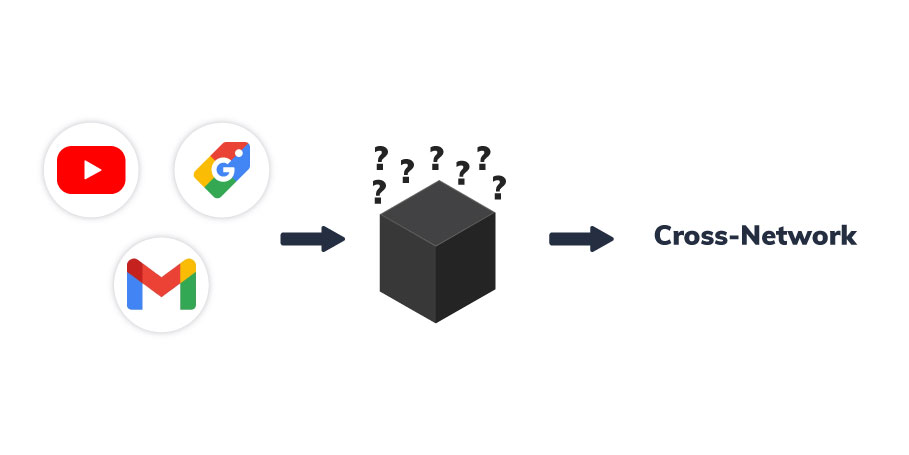
Smart Shopping campaigns appear on the Display network and Shopping network with a variety of placements including Gmail, YouTube, and Google Shopping. In a standard shopping campaign, you would be able to see which network and which placement your ad appeared for. With Smart Shopping campaigns, you’ll often see “cross-network” for the majority of placements.
We normally suggest attributing sales using a multi-touch approach (using an assisted model and a last-click model)—however this might not always be as effective for Smart Shopping campaigns.
If You Have More Display Traffic…
For example, if you use assisted + last click model and have more traffic on the display network, your display traffic will skew your model. This is because display ads are shown to a lot of users who might not be quite ready to buy—so they’ll appear to have “assisted” sales that in fact are driven by PLAs or text ads.
If You Have More Shopping Traffic…
On the other hand, if your Smart Shopping ads serve on the Shopping Network a last-click model could also be somewhat inaccurate. This is because users who are looking at Google Shopping are usually looking to buy and are close to converting. A last-click model would assign all the credit to your Shopping Ads, whether or not a user previously encountered other touchpoints on their journey.
The key to understanding attribution for Smart Shopping campaigns is to first understand your goals. Start by looking at which metrics are a reasonable representation of your actual campaign performance. Sometimes multi-touch is too generous, sometimes it’s fine—it really depends on your products and your business. Once you understand your business, you’ll know which model is best for tracking your overall profitability.

Problem #6: No Profit-Driven Strategy
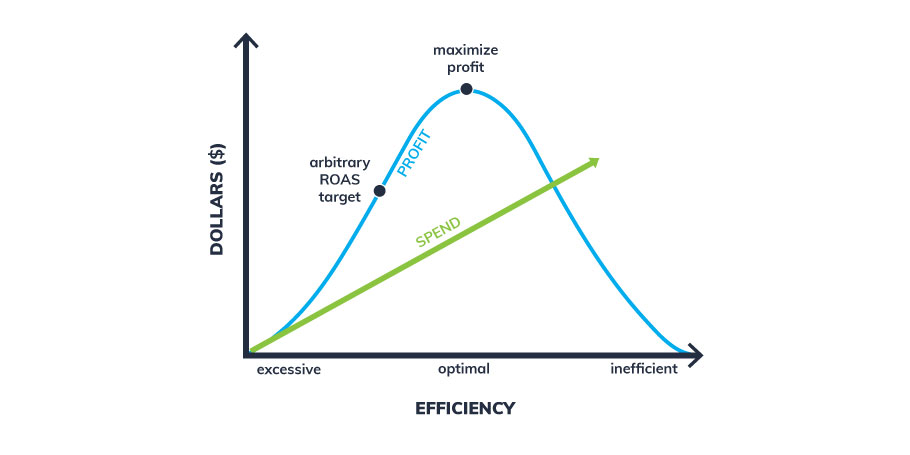
A profit-driven strategy is a strategy that allows you to maximize profit. Many of the levers we use to drive profit in a standard campaign aren’t available for Smart Shopping campaigns—but that doesn’t mean you still can’t implement a profit-driven strategy! All the recommendations we’ve made so far will help you grow the efficiency and overcome common problems with Smart Shopping Campaigns.
Segmenting by margin is perhaps the most important, followed by setting ROAS targets. These two steps will give you the most control over your Smart Shopping campaigns. Setting tiered budgets, keeping track of traffic, and tracking attribution all contribute to more profitable campaigns.
If you need help setting up Smart Shopping campaigns, reach out to speak with an analyst today.

